
Beneath the surface of the Brisbane Water estuary in New South Wales, Australia, rays are moving more than 57 metric tons of sediment each day as they forage and hunt for food. That’s according to a new study published in Remote Sensing in Ecology and Conservation. The finding highlights the underappreciated role that rays have in shaping their environment.
“We know [from other studies] that by moving sediment, rays change the topography, oxygen penetration, nutrient cycling, predator-prey dynamics, and other environmental attributes.”
Most of the rays at this 28-square-kilometer site are likely estuary stingrays, according to Molly Grew, a Ph.D. student in marine ecology at the University of Newcastle in Australia and first author of the new study. These relatively small rays—about 1.3 meters across—are endemic to Australia and considered near threatened. They feed mostly on crustaceans and marine worms by moving sediment to create feeding pits using a variety of tactics, including squirting water from their mouths and gills and flapping their winglike fins.
As rays shift sediment on the estuary bottom, they also inadvertently perform several ecosystem services. A recent study on the tidal flats of the Bijagós Archipelago in Guinea-Bissau found that excluding rays from study areas changed sediment properties and species composition, highlighting “substantial effects of ray bioturbation on the biotic and geomorphic landscape of tidal flats.”
“We know [from other studies] that by moving sediment, rays change the topography, oxygen penetration, nutrient cycling, predator-prey dynamics, and other environmental attributes,” Grew said. What hadn’t been known was how much sediment rays are moving.
Spotting Pits from the Skies
It can be “a real challenge to get out and manually measure ray feeding pits,” Grew said. That makes it difficult to figure out the extent to which the rays are affecting their habitats. So Grew left the water and took to the air.
She and her colleagues used a drone to collect high-resolution aerial images of ray feeding pits and calibrated the data gathered from those images by taking field measurements at 20 pits. The data helped Grew and her colleagues calculate the sizes of 1,090 feeding pits and extrapolate how much sediment rays are shifting.
Extrapolating their findings across the Brisbane Water estuary, rays are moving nearly 21,000 metric tons of sand each year, according to the analysis. That’s equivalent to the weight of about 500 fully loaded semitrucks.
And that’s probably an underestimate, according to Grew. “We focused on the areas where we could clearly see feeding pits in the aerial imagery,” she said. “We didn’t look at locations with seagrass, or under jetties, or in water too deep to see clearly using drones.”
That means rays are probably having an even larger effect on their environment than estimated in this study—a critical consideration given that ray populations are under threat in many areas, Grew said. “Losing ray populations can really hurt those ecosystems.” The sand in the estuary bottom can turn anoxic without rays digging into it and turning it over, for example. “Without rays, all the other creatures living in the sand would have no oxygen, and they would die out as well,” Grew said.
“This study shows that we have really underestimated the role of large megafauna, like rays, in influencing estuary sedimentary processes.”
“This study shows that we have really underestimated the role of large megafauna, like rays, in influencing estuary sedimentary processes,” said Simon Thrush, a marine scientist at the University of Auckland, New Zealand, who was not involved with the study.
Thrush and Alessandra Vallim Lima, a Ph.D. student in marine sciences at the University of Auckland, both cautioned that rays aren’t affecting their environment in isolation. Other factors such as wind and waves also change the shape of the seafloor and the biogeochemistry in estuaries and tidal flats. Ray feeding pits can last for a while or get filled up with sediment on the basis of their “precise location relative to wind direction on a specific day or wave action,” Lima said. “It’s a very dynamic process.”
Grew acknowledged that it may not be straightforward to extrapolate the results from Brisbane Water to other estuaries. “But I think the techniques we have developed can help researchers go out into other estuaries and use these techniques to measure how much sediment is being turned over by rays,” she said.
In fact, Thrush and Lima are also using drones in their own work at an estuary in New Zealand, which is confirming how extensively rays can affect their habitats. “When you look at the images from the drone and see the moonscape of craters and pits made by the rays, it really brings home the importance of this process,” Thrush said.
—Adityarup Chakravorty (chakravo@gmail.com), Science Writer
Citation: Chakravorty, A. (2024), Hungry stingrays shift serious amounts of sediment, Eos, 105, https://doi.org/10.1029/2024EO240367. Published on 14 August 2024.
Text © 2024. The authors. CC BY-NC-ND 3.0Except where otherwise noted, images are subject to copyright. Any reuse without express permission from the copyright owner is prohibited.
Related
